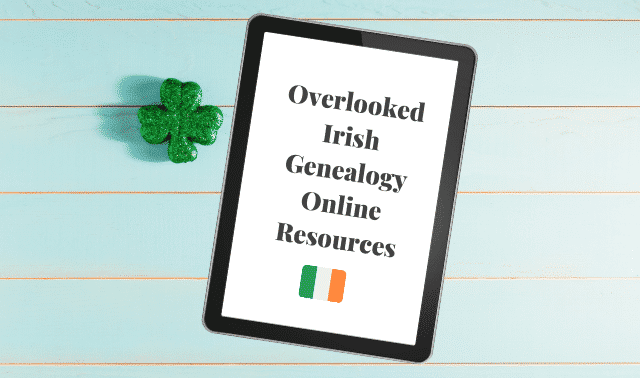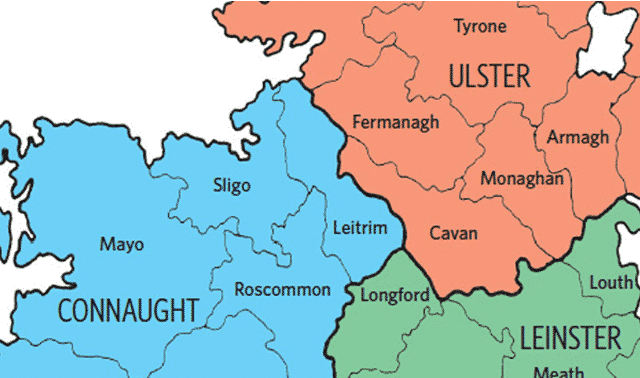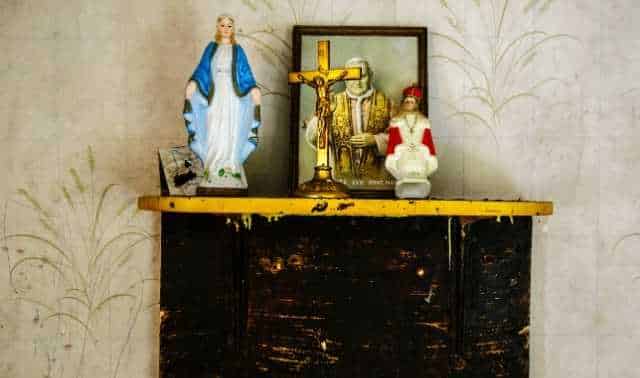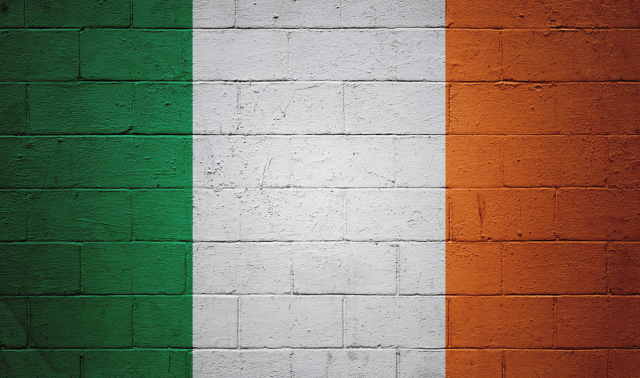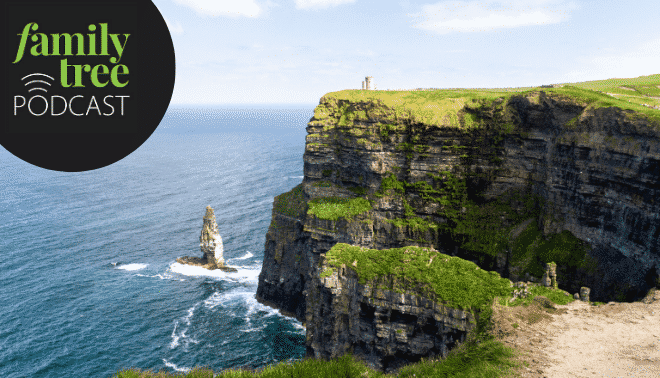Sign up for the Family Tree Newsletter Plus, you’ll receive our 10 Essential Genealogy Research Forms PDF as a special thank you!
Get Your Free Genealogy Forms
"*" indicates required fields

You may have heard that all Irish genealogy records burned in a 1922 courthouse fire. But that’s mostly just a tale, based on an unfortunate event during Ireland’s Civil War. Still, it morphed into received wisdom that researching ancestors from Ireland is a fruitless exercise.
Although it still gets the occasional airing, it’s a lot less prevalent these days. Over the years, it’s been responsible for many a would-be researcher giving up on learning about their Irish heritage. But we’ll have none of that defeatist attitude here.
Irish researchers face challenges in finding their Emerald Isle ancestors—there’s no point pretending otherwise. But that’s the case with research in any unfamiliar country. Non-native genealogists confront unrecognizable words and geography, different methods of recording information, and long centuries of historical events that have complicated the collection and preservation of records.
I can’t promise you an easy ride with Irish research, but at least there are no major language barriers. (Most records were kept in English.) Even the Latin you might encounter in Catholic records requires just a quick lesson to decipher.
It might take some practice to pronounce some tongue-twisting place names—let’s hear it for Muckanaghederdauhaulia and Dún Laoghaire—but you’ll catch on!
Let’s walk through the basics of Irish genealogy: the island’s history and geography, common Irish research pitfalls, and the best records for tracing your Irish ancestors.
1. Learn About Irish History
The first step to understanding your Irish ancestors is learning about the social and political issues of the era that led your ancestor to leave all that was familiar and take the often-perilous journey from Ireland to North America. The reasons for migration were different over the centuries, but nearly all of them included a desire to escape poverty or some level of religious persecution.
The best-known exodus occurred during the Great Famine that began in 1845. The choice for the poor was simple: Depart or die. The reduction in population during those years—more than 2 million by many estimates—tells its own tale. Over the next 70 years, nearly as many additional people emigrated. It wasn’t until Partition and Independence in the early 1920s that those who remained felt a greater hope of future self-determination.
For the genealogist to put the island’s last 150 years into context, you would do well to jump back to Gaelic Ireland and the Anglo-Norman invasion of 1170, then move forward in time. The key events to explore are:
- the Protestant Reformation (1600s)
- the exile of the last vestiges of the old
- Gaelic order (known as the Flight of the Earls; 1607)
- the Plantation of Ulster (founded in 1609)
- the Cromwellian Conquest (1649–1653)
- the Battle of the Boyne (1690)
- the Penal Laws (1695–1790s)
- the Great Famine (1845–1851)
- the Land War (beginning in 1879)
- Partition (1921) and Independence (effective in 1922)
Irish history sounds daunting, but needn’t be. I highly recommend the well-illustrated Atlas of Irish History, edited by Sean Duffy, and Jonathan Bardon’s easy-to-read A History of Ireland in 250 Episodes (both published by Gill & Macmillan). Check out other books and movies related to Irish genealogy.
2. Work Around Brick Walls
Remember that 1922 fire I mentioned earlier? It followed an explosion at Dublin’s Four Courts complex, home of the country’s Public Record Office. Ashes of Ireland’s priceless genealogical heritage rained down over the city. The major casualties were 19th-century Irish census returns, original wills dating to the 16th century, and more than 1,000 Church of Ireland parish registers.
Those hit hardest by these losses are researchers descended from Church of Ireland families (never more than 25% of the island’s population) and those whose ancestors were wealthy enough to make wills (again, a relatively small proportion). For the rest of us, the loss of the census returns was the greatest tragedy.
Even if Irish records avoided the PRO fire, they might have fallen victim to other perils: damp, insect infestation, human carelessness, or other damage. And then there were the Penal Laws, which made the keeping of registers potentially dangerous for priests and congregations. Indeed, while there are a few outliers, most surviving parish Roman Catholic registers don’t start until the 1820s. In some parishes, the start date may be as late as the 1860s.
So, yes, scarcity of early records can be an issue for Irish research. It’s hit and miss: an insurmountable problem for some researchers, but not for others. Your ancestors’ location, religion and level of wealth will determine how much luck you have.
Names can be another obstacle, as they often are in genealogy research. Most Irish parents drew from a narrow well when choosing names for their offspring before the 20th century expanded naming horizons.
Irish surnames can be terrifyingly common, too, making your ancestors hard to distinguish in records. For example, you’ll need both townland of origin and other information (parents’ names, ages and occupations) if you’ve a Patrick Sullivan from County Kerry or a Joanna Ryan from Tipperary.
Take a look at www.johngrenham.com/surnames to find out how localized a surname is in different regions or counties of Ireland. This might even help you narrow your search for a town of origin. For example, if you know Patrick Sullivan’s mother had an unusual maiden name, you could try searching that surname, then Sullivan to identify areas where both names are common.
And now for some good news: Nearly all of Ireland’s major genealogy collections can be accessed on free sites. In most cases, you don’t even need an account—you can just dip in and out at will. What’s not to like?
3. Study Irish Political Boundaries
In 1921, the island of Ireland was split into two entities: Northern Ireland (six counties in the northern province of Ulster) and Southern Ireland (the remaining 26 counties). Initially, both remained in the United Kingdom. But a year later, following the Irish War of Independence, the south seceded from the United Kingdom to form the Irish Free State (now the Republic of Ireland), while Northern Ireland chose to remain. A 310-mile border separates the two jurisdictions to this day.
That background is important to keep in mind, as are the various geopolitical entities that created records. Just as in the United States, Irish records were collected at different jurisdictional levels depending on their purpose. As such, US-based researchers can benefit from understanding the land and political divisions of Ireland. Below are the most important, organized from generally largest to generally smallest.
To find the divisional names relevant to your family, A New Genealogical Atlas of Ireland by Brian Mitchell (Genealogical Publishing Co.) will certainly help. Online, a good starting point is Samuel Lewis’s A Topographical Dictionary of Ireland 1837 (free online), as is John Grenham’s Irish Ancestors and its interactive maps and wonderful widgets. (At the latter, you can view a handful of pages free each month, or sign up for a short-term subscription for deeper exploration.) More free geographic resources are at www.swilson.info, www.logainm.ie/en and www.townlands.ie.
Provinces
The island is divided into four geographical provinces: Connacht (west), Leinster (east), Munster (south) and Ulster (north). Few, if any, records were kept at this level, and these regional divisions are mostly cultural. Most of Ulster is part of Northern Ireland, while the other three provinces (plus the Ulster counties of Cavan, Donegal and Monaghan) make up the Republic of Ireland.
Counties
Ireland has 32 historical counties. Some important records were collected and archived by county, and modern databases sometimes organize even other online records that way. Though these 32 counties are not necessarily used for administrative purposes in the present (especially in Northern Ireland, where they’ve been replaced by districts), they remain important to Irish identity, each with their own stereotypes and intercounty rivalries (especially in sports).
Baronies
Obsolete since 1898, the 330-odd baronies marked out boundaries in some old land records, surveys and early censuses.
Poor Law Unions
From the late 1830s, Poor law unions (PLUs) were formed from groups of civil parishes as local-government administrations centered on market towns. With the establishment of the General Register Office in 1864, PLUs became Superintendent Registrar Districts, the divisions responsible for documenting civil registration of births, marriages and deaths. (Wikipedia has a good map of PLUs, and Family Tree Magazine has its own free downloadable map.)
Civil parishes
Each barony was divided into civil parishes for the purposes of forming local governments. Ireland has roughly 2,500 civil parishes, and their boundaries may have shifted over the years.
Ecclesiastical parishes
With some minor alterations, Church of Ireland parishes overlap with civil parishes. Roman Catholic parishes, however, are a different matter, sometimes sharing names with civil/Church of Ireland parishes but containing different land areas to accommodate population changes. In addition, the Catholic Church has carved out many new parishes (especially after the Catholic Emancipation Act of 1829), sometimes resulting in historical registers being split between two entities. Ecclesiastical parishes were also formed into dioceses.
District Electoral Divisions (DEDs)
As the name suggests, DEDs organize voting by place of residence. They are also used in the collection of census records.
Townlands
Originally identified as an area big enough to support an ox, townlands vary in size depending on terrain and quality of soil. Most families (especially in rural areas) lived in the same townland for generations. So if records survive for the local area, knowing the townland (no easy feat, given there are more than 60,000 townlands throughout Ireland) is key to discovering your Irish heritage.
4. Find Your Townland of Origin
It’s worth repeating: The specific detail you need to progress your research in Irish records is the name of your immigrant ancestor’s townland. If you already know it, count your blessings. Unfortunately, after arrival in the United States, this golden nugget was rarely requested by officials.
As many researchers who have successfully tracked the ancestral homestead can confirm, you need to spread the net wide. Your first searches will be US records, especially death certificates, church records (look out for notes in margins), probate records, passenger manifests, arrival records, naturalization papers and military draft forms. Among the best sources are newspaper obituaries, headstone inscriptions and emigrant savings accounts, but be prepared to check any kind of document your ancestor created in his or her new home.
If, having exhausted your ancestor’s surviving documentation, you still can’t pinpoint the townland, rinse and repeat for each direct descendant and family member, working forwards through later generations. Extend this to early friends and neighbors of the immigrant, too; the Irish often stayed in contact or settled with people they knew before they caught the boat. Look out for witnesses to baptisms and marriages, guarantors to loans, and “referees” confirming good character (who may be extended family members or old pals).
Failing all this, use online forums (such as Boards.ie or RootsChat) to promote and broaden the scope of your search and reach the descendants of other family branches. If you’re narrowing down on a particular area, you could receive reliable guidance on county-specific forum boards and Facebook groups.
5. Find Irish Records
When you have wrung every drop of ancestral information—including townland of origin—out of US records, it’s time to cross the pond. Which Irish records you choose to delve into will depend on what you discover as your research progresses. But the seven collections noted below are those that will enable most family historians to build up a good amount of detail over multiple generations.
Fortunately, nearly all of these important collections are online and free to access. Unless otherwise noted, you can even search all the surviving records of that collection.
Censuses
Irish censuses were taken every 10 years from 1821 through 1911. Thanks to a mix of bureaucratic myopia and the 1922 fire, only the 1901 and 1911 returns survive in their entirety. A small collection of census fragments from 1821, 1831, 1841 and 1851 holds fewer than 400,000 names in total. The next census returns to be released will be those from 1926 in the Republic of Ireland and 1937 in Northern Ireland.
Ireland’s surviving censuses can be searched for free on The National Archives of Ireland’s website. We’ve got a search tutorial. Ancestry.com, Findmypast and MyHeritage also have census collections.
Church records
The availability of Irish church records varies by denomination and time period. Though the majority of Irish were Roman Catholic, notable minority faiths included the Church of Ireland (the Established Church on the island) and Presbyterians:
Roman Catholic
By far the largest religious group across Ireland, Roman Catholics were hit hard by Penal Laws following the Reformation and establishment of the Protestant Church of Ireland. The laws made recordkeeping difficult and potentially dangerous for priests and their congregations, so be prepared for patchy coverage of registers. While the earliest registers date back to 1671 (Wexford Town), most start in the 1820s, shortly before Catholic emancipation. In some parishes, no pre-1860 records survive.
The National Library of Ireland published unindexed images of its microfilmed collection at (free). They run to 1881, and you’ll find free indexes at Ancestry.com and Findmypast.
Another major collection, typically spanning into the 1920s or later, is held at RootsIreland. This covers most of the island. Missing areas—such as south and west Cork, Dublin City, and Kerry—can be found at www.irishgenealogy.ie.
Church of Ireland
As the Established Church after the Reformation, the Church of Ireland was to keep records of Protestants. While some early registers survive for urban parishes, the majority date from the late 18th or early 19th centuries.
The Church of Ireland’s archive is held by the Representative Church Body (RCB) Library in Dublin, which holds most of the parish registers that were not destroyed in the PRO fire of 1922. It publishes a useful and regularly updated List of Parish Registers, identifying those that were lost and detailing where you can access surviving records online and offline. Download the PDF.
The RCB Library plans to launch a free, fully searchable online database of its registers, complete with images. Keep an eye on the Library’s news pages at www.ireland.anglican.org/about/rcb-library/library-news.
Presbyterian
Settlers from Scotland brought Presbyterianism to Ireland, especially to Counties Antrim and Down, in the early 17th century. Like Catholics, they suffered severe restrictions under the Penal Laws. By 1861, there were 650,000 Presbyterians across the island, forming more than 400 congregations, and their baptism, marriage and burial records generally date from the 1820s.
RootsIreland holds records for all nine Ulster counties and smaller collections in other provinces. Offline, PRONI has microfilms of nearly all surviving registers, while the Presbyterian Historical Society of Ireland holds a small and exclusive collection.
Methodists
Until the 1820s, the records of Methodists are usually found in the registers of their local Church of Ireland church. A handful of Methodist-only registers date from 1815, but most start in the 1830s to 1840s. RootsIreland has some transcribed records, and PRONI has a large microfilmed collection. For more details, contact the Methodist Historical Society of Ireland.
Quakers (Society of Friends)
Most Quaker records of births, marriages and deaths date from the 1670s. Subject to the 100-75-50 year privacy rule, the collection is accessible to subscribers of Findmypast. Learn more details.
Civil registration
Ireland’s civil registration system started in 1845, but only for non-Roman Catholic marriages. Registration of births, deaths and all marriages was introduced in 1864 and was organized and collated by Superintendent Registrar Districts. While most marriages were registered, about 10% of births and deaths are estimated to have not been recorded in the first decade after the system launched. We’ve got a guide to researching Irish civil registrations here.
Out of consideration for privacy, publication of records is subject to the 100-75-50 year rule: Births less than 100 years ago, marriages less than 75 years ago, and deaths less than 50 years ago are restricted. Indexes and register images are online at the free IrishGenealogy site under Civil Records. (At time of writing, the final installment of available register images—for deaths 1864 to 1870—is still in progress.)
Historical civil registration records of births, marriages and deaths that occurred in districts now in Northern Ireland are available from the General Register Office of Northern Ireland via its online database. The index is free, but you’ll need to pay a small fee to view register images for additional information.
Griffith’s Primary Valuation and Ordnance Survey Maps
Between 1848 and 1864, every civil parish in Ireland was assessed for taxable land and property. Named for Richard Griffith (who headed up the survey efforts), “Griffith’s” Valuation is a critical record for 19th-century research. Surveyors noted the names of heads of household and landowners, the acreage and value of the land and property, and the tax assessment. These lists are organized by county, barony, poor law union, civil parish and townland.
Each of the entries was assigned a reference number/letter that corresponds to Ordnance Survey maps created in the 1830s. These maps mark out fields, buildings and other land features, so you may be able to identify the exact location of your ancestral family’s home.
The only free online site to search Griffith’s Valuation is Ask About Ireland. It can be a bit sluggish, so you might prefer researching it at Findmypast or Ancestry.com if you have a subscription at either. Bear in mind the maps in each collection are not identical.
Tithe applotments
The Tithe Applotment Books (1823 to 1837) are arranged by parish and recorded those who rented or worked agricultural land (except church lands). If your ancestors lived in urban areas or did not work on the land, they won’t have been included. However, if your ancestors lived in a rural parish for which no pre-1850 church registers exist, this collection may hold the only documented record of their lives. The National Archives has online versions of the books that are free to search and view; the books for Northern Ireland are free at PRONI.
Headstones
The transcription of headstone inscriptions, which often reference names, dates and places, is not new or unique to Ireland. But it has become very much a group activity in recent years. Most of the resulting record sets are now online, but they are scattered across the Internet, at both free and subscription sites. For a summary, see my free list.
Newspaper obituaries
The day digitization of newspapers became possible was a game changer for family historians around the world. While a newspaper death notice may provide perfunctory information, an obituary or funeral report often provides a wealth of detail, including place of origin and residence. For Irish obits, try the Irish Newspaper Archives, the British Newspaper Archive (its 200+ Irish titles are also at Findmypast), and, from 1859, the archive of The Irish Times newspaper.
The Future of Irish Genealogy
In terms of major surviving record sets, there are arguably only three big holes in the Irish genealogy menu:
- the Registry of Deeds collection, which dates back to 1709
- the Representative Church Body (RCB) Library’s huge archive of Church of Ireland parish registers
- Griffith’s Valuation Revision Books for the Republic of Ireland
Digitization, indexing and imaging projects are underway for all three. And while their online launches may still be some time ahead, they are at least in progress. In the meantime, if you should hear that story about the all-destroying Four Courts fire, please dampen the flames.
A version of this article appeared in the March/April 2021 issue of Family Tree Magazine. A similar article by Sharon DeBartolo Carmack appeared in the March 2008 issue of Family Tree Magazine.
ADVERTISEMENT



